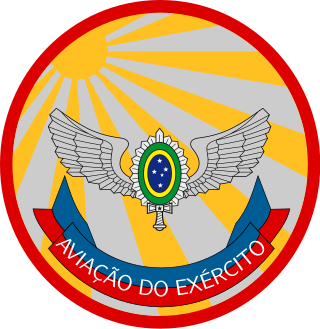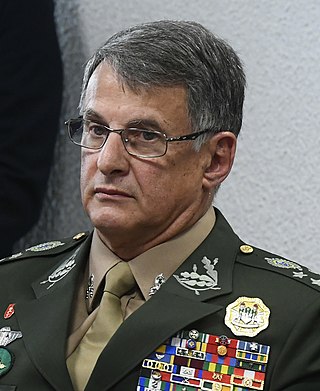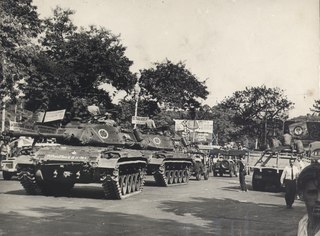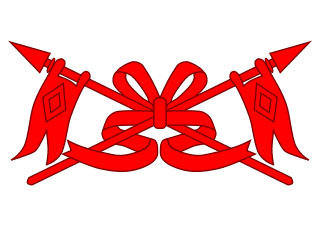
João Batista Mascarenhas de Morais was a Brazilian army officer and commander of the Brazilian Expeditionary Force in the Second World War. He was ranked Field Marshal and was the last active Brazilian marshal.

The Brazilian Army is the branch of the Brazilian Armed Forces responsible,externally,for defending the country in eminently terrestrial operations and,internally,for guaranteeing law,order and the constitutional branches,subordinating itself,in the Federal Government's structure,to the Ministry of Defense,alongside the Brazilian Navy and Air Force. The Military Police and Military Firefighters Corps are legally designated as reserve and auxiliary forces to the army. Its operational arm is called Land Force. It is the largest army in South America and the largest branch of the Armed Forces of Brazil.

The Military Academy of Agulhas Negras is the biggest among several schools of formation of combatant officers of the Brazilian Army. It originated in 1792 with the creation of the Royal Academy of Artillery,Fortification and Drawing,the first military school of the Americas,in the city of Rio de Janeiro. Today the Academy is located in the city of Resende,in the state of Rio de Janeiro.

The MAX 1.2 AC,—previously known as MSS 1.2 AC—is a Brazilian anti-tank guided missile (ATGM). Operated by infantry or vehicles,the system consists of a reloadable launch tube,laser-guided missile and firing unit,as well as a simulator and testing equipment. It was developed out of Oto Melara's “Missile Anti-Carro della Fanteria”,which was rejected by the Italian Army. Brazilian involvement began in 1986 and it has since then been tested and redesigned by the Brazilian Army's research institutes and a series of Brazilian companies.

The Brazilian Army Aviation is the air segment of the Brazilian Army,operating rotary-wing aircraft (helicopters) in conjunction with surface forces such as the 12th Light Infantry Brigade (Airmobile). Originally founded with aircraft in 1919,it ceased to exist in 1941,re-emerging in its current form in 1986. It has mainly transport aircraft in addition to light attack helicopters,but does not use dedicated attack helicopters. Its command (CAvEx) in Taubaté,São Paulo,is linked to the Land Operations Command,in Brasília,and the Southeastern Military Command. CAvEx only has subordinates in the 1st and 2nd battalions,also in Taubaté. The 3rd and 4th are respectively in Campo Grande and Manaus,subordinate to the Western and Amazonian Military Commands,and there is a detachment in Belém,in the Northern Military Command.
The Amazon Military Command is one of eight Military Commands of the Brazilian Army. The Amazon Military Command is responsible for the defence of the Amazon Basin. Four Infantry Brigades specializing in Jungle warfare,one construction Engineer Brigade and one Military Regional Command are subordinated to the CMA. Its area of responsibility covers the states of Amazonas,Acre,Roraima and Rondônia.
The Eastern Military Command is one of eight Military Commands of the Brazilian Army. The Eastern Military Command is responsible for the defense of the states Rio de Janeiro,Minas Gerais,and Espírito Santo. A Parachutist Brigade and two Infantry Brigades are assigned to the 1st Army Division,which is the maneuver unit of the CML. Two Military Regional Commands are subordinated to the CML for administrative purposes.
The Northeastern Military Command is one of the eight Military Commands of the Brazilian Army. The Northeastern Military Command is responsible for the defense of the states Bahia,Sergipe,Rio Grande do Norte,Paraíba,Pernambuco,Alagoas,Ceará,Piauí,and Maranhão. Three Military Regional Commands are subordinated to the CMNE for administrative purposes.

JoséPessoa Cavalcanti de Albuquerque was a military officer,who became a Marshal in the Brazilian Army. Son of Cândido Albuquerque and Maria Albuquerque,he was the nephew of Epitácio Pessoa,and brother of João Pessoa,the Governor of Northern State of Paraíba. He was one of the officers sent on a preparatory mission to Europe by the Brazilian Army during the World War I against the Central Powers. In his subsequent career he had a strong influence on the reform and update of some Brazilian Army branches and institutions. To honor him,the 12th Cavalry Regiment of the Brazilian Army adopted his name.
The Battle of Pirajá was fought as part of the Independence of Bahia and more broadly,as part of the War of Independence of Brazil. It was fought in Pirajá,now a neighborhood of the city of Salvador,Bahia on November 8,1822. The Battle of Pirajáwas the largest engagement in the fight for the independence of Bahia,involving approximately 10,000 troops.

General Edson Leal Pujol is a General in the Brazilian Army. He was the Brazilian Army Commander,from January 2019 to March 2021.

Joaquim Silva e Luna,is a Brazilian politician and former Brazilian Army general who served as Minister of Defence from February 2018 until January 2019.

General Geraldo Antônio Miotto was a senior officer of the Brazilian Army. As a member of the Army High Command,he was the Commander of the Amazon Military Command and Southern Military Command.

The term "military apparatus" refers to a policy of appointing officers of the Brazilian Armed Forces during the government of João Goulart (1961-1964),consisting of favoring,in promotions and nominations to important commands,military officers considered reliable. It is considered the work of the head of the President's Military Cabinet,Argemiro de Assis Brasil,who,however,later denied its existence. The filling of the high commands with loyal officers was supposed to assure the president's mandate and was considered relevant both within the government and the opposition. However,it did not prevent the deposition of Goulart in the 1964 coup d'état,which was joined by members of the "apparatus",some of whom had participated in the preceding conspiracy.

The Brazilian cavalry is one of the branches that make up the Brazilian Army. It operates in armored vehicles and,like the infantry,has the role of directly confronting the enemy,but with distinct missions such as reconnaissance and vanguard. It is organized into regiments and squadrons,which are equivalent to the infantry's battalions and companies. Its main types are tank,mechanized,armored and guard. Its troops serve in vehicle crews or as fusiliers on board,who can also fight on foot.

Marco Antônio Freire GomesGCMM is a retired Army general of the Brazilian Army,Commander from 31 March to 30 December 2022.
Júlio Cesar de Arruda is a general in the Brazilian Army. He has served as chief of the army's Department of Engineering and Construction. He was the commander of the Brazilian Army from 30 December 2022 to 21 January 2023.

Tomás Miguel MinéRibeiro Paiva is a Brazilian army general,incumbent commander of the Brazilian Army.

Euler Bentes Monteiro was a Brazilian military officer.














